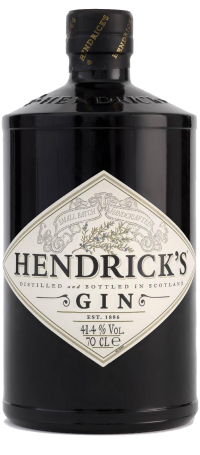Home Deconstruction for My Anniversary
February 16, 2013
Happy Birthday to me!
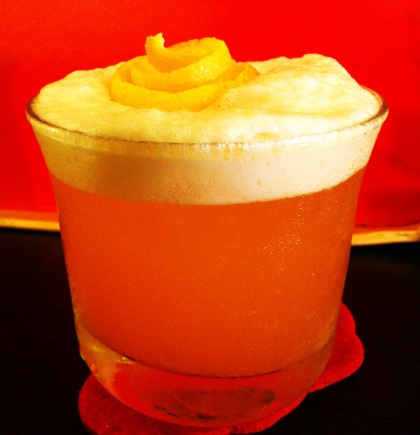 The Boo Lion turned one last week, so I decided to get busy with the power tools and do a little deconstruction work.
The Boo Lion turned one last week, so I decided to get busy with the power tools and do a little deconstruction work.
But first, some thanks to those of you who have helped me during my first year, and yes, I mean you, the readers. I’m very grateful to my friends, and anyone who stopped by to read this blog. I’m always pleasantly surprised when I run into a friend I haven’t seen in a while, and they say how they’re enjoying reading my blog. The even greater surprising pleasure was the wonderful kindness and support from complete strangers in the cocktail blogging community. I hadn’t even read blogs before I started this one, and I was amazed at how nice and friendly other bloggers can be.
Thanks a lot guys!
Anyway, after a year it’s about time to pull out the power tools in service of mixology.
Last week, I blogged about Negronis. I left out one of the most fun – the Deconstructed Negroni.
The Deconstructed Negroni has nothing to do with Derrida and postmodernism. It’s about separating out some of the ingredients through the technology of molecular mixology, specifically nitrous canisters to create foam. I know it doesn’t sound like a job for the average kitchen cocktailian, but don’t despair, there is another method!
The Deconstructed Negroni is made by Charlotte Voisey as a version of her Unusual Negroni, which I featured last week, but with the Aperol being made into a foam that sits on top of the gin and Lillet Blanc mix.
If, like me, you don’t have nitrous canisters, you can use a whisk. Eric Felten recommends using a sturdy wide mixing glass, and rubbing a small whisk between your hands like a boy scout rubbing a stick to make fire. I don’t have a small whisk, and I wasn’t very happy with my resulting foam (although it was still quite passable). Electric whisks are very expensive in this country. Electric whisk heads are not. Neither are power drills.
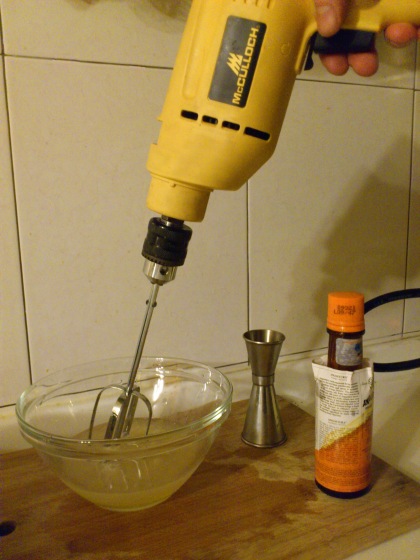 Oh, yeah! That’s the way I do it.
Oh, yeah! That’s the way I do it.
 I can’t believe I waited a year to use power tools in the service of the cocktail arts.
I can’t believe I waited a year to use power tools in the service of the cocktail arts.
1 1/2 oz gin
1 1/2 oz Lillet Blanc
Aperol foam
Lightly stir gin and Lillet over ice in a rocks glass. Spoon Aperol foam on top.
Aperol Foam
1 oz Aperol
1 egg white
2 oz strained grapefruit juice
2 tsp orange bitters*
Whisk ingredients into a frothy foam (with whisk, electric beater or power drill).
First of all 2 teaspoons of orange bitters is a hell of a lot! I like my Angostura Orange Bitters, but they’re very strong, and can easily overpower a drink. I used two small dashes, and less would have been fine. But you certainly want some, as I think orange is very important in a Negroni.
As with the Unusual Negroni, you want a light and/or citrusy gin with this one – Plymouth and Hendricks work well.
Finally if, you don’t have Aperol and Lillet, you can use the usual Negroni ingredients – sweet vermouth and Campari. This makes a good drink, but the Aperol and Lillet combo is better.
The drink is a winner! It’s fun to make, good to look at or show off, and delicious to drink.
Addendum
A final Negroni variation I neglected to mention is apparently quite chic in cocktail circles now, but I don’t have ingredients for it. It’s the White Negroni. Putney Farm has a great article about it, and Jason Wilson has a recipe in the Washington Post. I’m on holiday for a couple of weeks, and checking out a few of Wellington’s cocktail bars. Maybe I’ll get a chance to try one.
Americano, Negroni, Sbagliato!
February 8, 2013
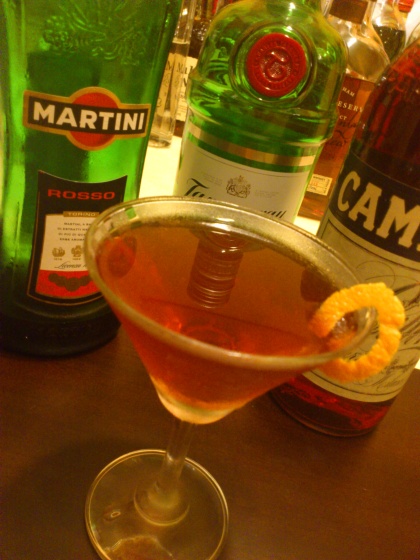 This post is mostly about the Negroni, but I’m going to start with an Italian lesson.
This post is mostly about the Negroni, but I’m going to start with an Italian lesson.
1. americano (n)
An Americano is a drink made with bitters (Campari), vermouth and soda. According to most sources it got its name around about the 1890s because of all the American tourists drinking it. I call bullshit. Were there loads of American tourists in Italy in the 1890s? Did they then choose to drink strange bitter European liqueurs? I think the more likely explanation is that the name came from ‘ameri’ the word for ‘bitter’. I have no evidence to back this up.
2. Negroni (n)
The name of an Italian Count who wanted to strengthen his Americano by subbing gin for soda. It worked, and the story seems a little more legit, although there are at least two Italian Counts vying for the credit.
3. sbagliato (adj)
Mistaken, as in, “I mistakenly poured champagne into your Negroni, instead of gin, by mistake. (Mama Mia!)”. You mistakenly what? No I don’t believe it. The Beefeater and the Asti Spumante look nothing alike. The bubbles weren’t a giveaway? Now, I read that the drink usually called ‘Negroni Sbagliato’ is simply called ‘Sbagliato’ in Italy. Back in the day, cheap (or not-so-cheap) dry sparkling wine was often used as a luxury version of soda water. So the Sbagliato is really just a luxury Americano, but maybe its invention really was a happy mistake.
Now that we’ve learnt the lexicology, let’s get on to the boozeology.
The Americano was actually originally called the Milan-Turino. It was invented by Gaspare Campari, who was a master drinks-maker by the age of 14, invented the most famous bitters in the world and founded the company that was to become the sixth-largest multinational spirits producer. Quite a guy! He was from Turin, but moved to Milan and opened his Caffe Campari there, naming his signature drink after his two home cities, which were also home to the two ingredients, his own Campari, made in Milan, and Cinzanno Vermouth, made in Turin.
1 1/2 oz Campari
1 1/2 oz sweet vermouth
soda water
orange or lemon slice
Build over ice in an Old_Fashioned glass, top with a squirt of soda and garnish with orange or lemon slice. Alternatively, build in a highball glass of ice and add about 2 oz of soda.
Lemon is the traditional garnish and orange was used in the Negroni to distinguish it, but personally I think that the orange just works better with the Campari.
The Americano is a nice enough drink, but the improvements are better.
As mentioned, if you use sparkling wine instead of soda water, you get a Sbagliato. This drink was invented (mistakenly or not) by bartender Mirko Stochetto, at the Bar Basso in Milan during the 1960s.
1 1/2 oz Campari
1 1/2 oz sweet vermouth
dry sparkling wine
orange slice
Make in the same way as an Americano, in an Old-Fashioned glass, although, for fun, I like to put it in a Champagne glass.
For authenticity, the sparkling wine should really be Italian. It seems that the original was probably Asti Spumante, but it’s trendier to use Prosecco, these days. There’s nothing wrong with using cheap Champagne, Cava or something else, though. I’ve tried all three, and like this drink quite a lot. It’s light, fun and easy to drink.
That finally brings us to the Negroni – the strengthened (and I think much improved) version of the Americano.
The most probable story of the invention of the Negroni was that the Italian playboy Count Camillo Negroni (when returning to Italy after having been a cattle rancher in the US for a while when he fled home due to the fathering an illegitimate child), drinking Americanos at the Cafe Casoni in 1919, decided to strengthen them with a bit of gin. A classic was born.
1 oz gin
1 oz Campari
1 oz sweet vermouth
orange slice or zest
Combine in an Old-Fashioned glass of ice and stir, or stir in a mixing glass of ice and strain into a coupe or Martini glass. Garnish with orange slice, wheel, wedge or zest.
That’s the drink, in all its simplicity. Now let’s get on to some choices and variations:
The simplest choice is if you want it on the rocks or up. Apparently in Italy it is always served in an Old-Fashioned glass with ice, but in recent years, cocktail fans have been straining it into a cocktail glass. I prefer the latter approach. It seems to make a nicer drink to me, and can also be a beautiful clear red which just makes it more appealing.
A few drops of Angostura or orange bitters is another common choice, although it’s not really necessary, given that Campari is, itself, a form of bitters. That said, I do like a couple of drops of orange bitters in my Negroni, especially if I’m using Aperol instead of Campari and using lighter citrusy gin.
Which brings me to the gin. I think the best choices are either a good traditional London dry like Tanqueray (one of my top choices) or a milder gin with good hints of citrus, such as Plymouth Gin. I wouldn’t recommend more herbal gins like Bombay Sapphire or the Botanist, really.
One trend is to increase the amount of gin. Personally, I think this is a mistake. I don’t really consider the Negroni a ‘gin drink’. With the equal parts formula, the three ingredients come together to create a completely new third flavour which is neither gin, Campari nor vermouth – the Negroni flavour. I think you lose this if you up the ratio of gin. You have a new gin drink, which is not a Negroni, nor is it as good.
Another, much better, trend is to use the Negroni template – gin, bitters, vermouth-like sweetener – to create similar drinks. There are quite a lot of these, but many require Amari (Italian potable bitters) that I just can’t get. Neither can I get any kind of sweet Vermouth (Carpano Antica, and Punt-e-Mes are popular ones) other than Martini and Rossi. Here are a few that I have tried:
1 oz gin
1 oz Aperol
1 oz Lillet Blanc
orange twist
Stir ingredients with ice (or ‘throw’) and strain into a cocktail glass. Garnish with orange twist.
This drink was created by bartender Charlotte Voisey for Hendrick’s Gin, and it’s a good gin for the drink. A lighter gin is called for, and one with good citrus flavours, so I’ve also found that Plymouth works well in this drink. Aperol is a lighter, more orangey, sweeter version of Campari (read to the end for availability in Taiwan), and can work well to introduce those wary of Campari to Negronis. The Aperol, being sweeter, is balanced by Lillet Blanc, being less sweet than Italian vermouth. Lillet is an aperitif wine with a similar profile to vermouth, but again, like all ingredients in this drink, it’s lighter and brighter. I like to add just two drops of Angostura Orange Bitters, as well.
Voisey ‘throws’ this drink to create some aeration, but I haven’t actually tried that myself.
The Unusual is my favourite Negroni, and a great bet if you want to win someone over to the drink. In my experience, no one likes their first Negroni, so see if you can make this their (or your own) second.
But sometimes you don’t want light:
1 oz gin
1 oz Cynar
1 oz sweet vermouth
1 dash bitters
2 wedges orange
Shake liquid ingredients and juice of one of the wedges with ice. Strain into a cocktail glass and garnish with the other wedge.
Jason Wilson attributes this variation to bartender Chris Cunningham, and writes of it, and other variations, in his book ‘Boozehound’, and in a Washington Post column.
Cynar (sadly unavailable in Taiwan) is the fantastic artichoke liqueur that I’ve written about before. It makes this Negroni rich and herbaceous. Another winner.
1 1/2 oz gin
1 1/2 oz sweet vermouth
2 dashes Fernet Branca
orange twist
Stir well with ice in a mixing glass and strain into a cocktail glass. Garnish with an orange twist.
Ted Haigh unearthed this cocktail, created by Ada Coleman at the Savoy Cocktail, home of one of the most influential cocktail books ever. He stresses the importance of actually expressing the essential oils in the orange before garnishing. He also says that the drink languishes because of its unfortunate name. I love the name! Apparently, upon tasting it, a certain Sir Charles Hawtrey declared “By Jove! That is the real Hanky Panky!”
I agree with Charles. This might be a bit clichéd for cocktail geeks, but Fernet Branca (alas, also not to be had in Taiwan) is one of my very favourite drops. I use a teaspoon in this drink. The proportions are different from a standard Negroni, but the Fernet is stronger, and a lot more bitter than Campari, so it still has a definite Negroni-ness. It’s great.
Deconstructed Negroni
Another good one, but I’m going to cover that in my next post.
1 oz gin
1/2 oz Cointreau
1/2 oz Campari
1/2 oz dry vermouth
orange twist
Stir with ice in a mixing glass and strain into a cocktail glass. Garnish with the twist.
Another drink from Ted Haigh’s Vintage Spirits and Forgotten Cocktails, named after a famous French fencer from the 20’s. It makes sense as a Negroni with the added orangey flavours of Cointreau, but I wasn’t too thrilled with it. I think it needs a bit of Orange Bitters, and would quite likely also work better with Aperol instead of Campari.
1 1/2 oz Bourbon
1 oz Campari
1 oz sweet vermouth
orange twist or cherry
Stir with ice in a mixing glass and strain into a cocktail glass. Garnish with orange twist or cherry.
I’ve left this to last for the obvious reason that it’s not a Negroni at all, being made out of Bourbon rather than gin. No matter, it’s a wonderful drink that stands up to both the Negroni and its other relative the Manhattan in quality. I’d recommend it to anyone.
Conclusions
The Negroni is a marvellous drink, not only of itself, but in the way it can be easily adapted. I’ve only listed a few of the variations, being, as I am, constrained by my lack of alternatives for the Campari and the Vermouth, but there are countless variations possible. Try one.
Note: I have found Aperol in only one place in Taiwan, a small distributor called Fontanbev. Their website is a horrible Flash mess, so if you can’t navigate it, their address is Zhongxiao E Rd, Sec 5, No. 508, 21F-3, and they have a small shop on the first floor of the back of that building (Phone 02-2759-1358). The Aperol is about 900NT, I think. I’ve mentioned before that you can get Lillet Blanc from Sundy.
Pisco Sour
January 30, 2013
 It’s National Pisco Sour Day! Well, it is if you’re lucky enough to live in Peru.
It’s National Pisco Sour Day! Well, it is if you’re lucky enough to live in Peru.
Pisco is a delicious white spirit native to Peru and Chile. It’s a kind of brandy, really, as it is distilled from grape wine. But unlike brandies such as Cognac, it’s generally unaged (or aged for a very short time). This gives it a taste somewhat similar to grappa. It’s refreshing, exuberant and fruity. I only have one brand – Control from Chile – but I love the stuff.
A sour is a drink consisting of spirits, lemon or lime, and sugar; the Whiskey Sour being the most well-known.
So a Pisco Sour is just Pisco, lemon or lime, sugar and a bit of egg white and Angostura Bitters.
This combination was invented by an American bartender called Victor Morris, who had a bar in Peru. The Chileans, also claim that they invented the Pisco Sour, but that claim now seems false.
When I tried my first Pisco Sour a few months ago, I was quite blown away. I often try good drinks that are very nice, but this one was very nice, and different as well. A lot of the vintage recipes I try are just new combinations of familiar flavours, but the Pisco Sour was really something new.
Egg white is a very important ingredient in the Pisco Sour, and although that can put a lot of people off, it’s actually very safe, and also doesn’t really affect the taste. It’s mostly there for the texture. Texture in cocktails is an important thing that I’ve been thinking about a bit recently. Foams are good.
The biggest argument over the best Pisco Sour lies in whether to use lemons or limes. It seems that this is mostly a national difference. In Chile they use lemons (and powdered sugar), in Peru they use limes (and simple syrup). I tried both, and prefer lemon. Maybe it better suits my Chilean Pisco. So if you’re trying Pisco Sours, try both and drink what you prefer. There’s no correct answer.
Pisco Sour
1 1/2 oz Pisco
3/4 oz lemon juice
1 tsp sugar
a few drops Angostura Bitters
a small egg white
Dissolve the sugar in the lemon juice then add the egg white and Pisco. Shake well without ice to let the egg white mix properly (optionally including a couple of drops of bitters), then shake again with ice. Strain into a coupe glass. Top with a few drops of Angostura Bitters.
The egg makes a nice foamy head to the drink and the Bitters sit on top, so it’s common to use a swizzle stick or something to swirl the bitters into a pattern. If you want to get really fancy you can make a stencil and spray the bitters through a mister to create a logo or something. However you do it, the bitters add a nice aromatic touch to the drink, so they’re pretty important.
On the subject of bitters, some say that the correct bitters to use are Amargo Bitters, from Peru, but I’m not so sure about that. Angostura Bitters is more commonly used now, and may also have been the original. I’d like to try.
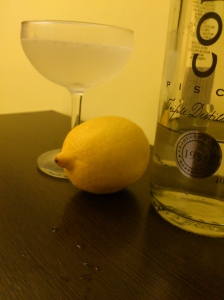 The other big Pisco drink is Pisco Punch, a potion that originated in San Fransisco and became immensely popular in the US during the 19th century. It is made with Pisco, pineapple syrup, and lemon juice. It’s good, but I like the sour better, so I’d rather split the difference, add some egg white and bitters, and make my Pisco Punch as a Pisco Sour with pineapple syrup instead of sugar. Try it – it’s good.
The other big Pisco drink is Pisco Punch, a potion that originated in San Fransisco and became immensely popular in the US during the 19th century. It is made with Pisco, pineapple syrup, and lemon juice. It’s good, but I like the sour better, so I’d rather split the difference, add some egg white and bitters, and make my Pisco Punch as a Pisco Sour with pineapple syrup instead of sugar. Try it – it’s good.
Happy Pisco Sour Day!
*Note for readers in Taiwan: AFAIK there are currently three brands of Pisco available in Taiwan. Control for about 900NT from Breeze, Tres Erres from Megacity City Super for about 650NT, and Mistral from Jason’s in Banqiao FE21 for about 1000NT.
Hot Buttered Rum
December 20, 2012
As the temperature dropped below 12 degrees a couple of days ago (that’s practically sub-zero in Taiwan terms) I continued with hot drinks.
I revisited Hot Buttered Rum. For some reason, I hadn’t liked it much when I tried it last winter. This time, it was fantastic. I made it again the next night, doubled the recipe and almost wiped myself out. It’s deliciously potent.
There isn’t much hard historical knowledge about Hot Buttered Rum. Wondrich says that buttered drinks date back to at least Henry VII, and that it was quite likely in rum-loving New England that the rum version was popularised.
The drink has had its haters. Celebrated 1940s cocktail writer David Embury hated it, and I’ve often read that people just don’t like the butter (or the ‘layer of slick’ that it leaves). In my opinion, it really works. Anyway, it’s not worth getting hung up on. Try it, and if you don’t like it, leave it out and you’ve still got a great drink – Hot Spiced Rum.
There are, of course, many different versions, but once again I tried and loved the one given by veteran New Orleans bartender Chris McMillian – check out the video below.
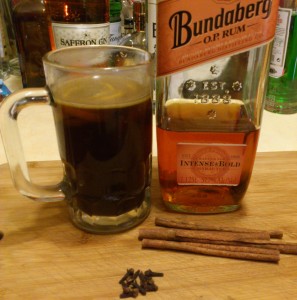
Hot Buttered Rum
2 oz Jamaican-style rum
3 oz hot water
3 tsp brown (Demerara) sugar
1 cinnamon stick
2 whole cloves
a little allspice
very large orange zest
knob of butter
Pre-heat a glass with hot water and discard after a couple of minutes. Dissolve sugar in a little hot water. Add rum and spices. Add hot water and stir. Dissolve a knob of butter on the top.
I really liked this drink. I didn’t have Demerara sugar, but I’m sure the brown sugar made a lot of difference over the white I probably used last time. It was nice and rich. The Christmas spices were great, even though I didn’t have allspice. I used the zest of almost a whole orange, and again, it was killer. The butter? I think it added a bit of body. Hot drinks can be a bit thin sometimes. I certainly didn’t dislike it.
You can double this mixture, but if you’re using 58% overproof rum, like I was, you might not be able to do much afterwards!
MXMO: The Black Krampus
December 15, 2012
 The holiday season is upon us, so I’m going to bring you a nice hot drink, courtesy of that traditional Yule figure from the north. The one who keeps a list of which children have been naughty and nice, and visits them at Christmas time to give them what they deserve.
The holiday season is upon us, so I’m going to bring you a nice hot drink, courtesy of that traditional Yule figure from the north. The one who keeps a list of which children have been naughty and nice, and visits them at Christmas time to give them what they deserve.
No, I’m not talking about the fat man, but this guy:
 Meet Krampus.
Meet Krampus.
Yeah. He looks like a cross between Beelzebub and the Pedo Bear, right?
 According to some Germanic traditions Krampus accompanies St Nick (or sometimes works of his own accord) and punishes the naughty children at Christmas. If you’ve only been a little bit naughty, he’ll just swat you with his birch branches, but if you’ve been bad, he’ll carry you off to eat or to throw you into the fires of hell (at least that’s what he tells us – I wouldn’t trust my kids alone with him).
According to some Germanic traditions Krampus accompanies St Nick (or sometimes works of his own accord) and punishes the naughty children at Christmas. If you’ve only been a little bit naughty, he’ll just swat you with his birch branches, but if you’ve been bad, he’ll carry you off to eat or to throw you into the fires of hell (at least that’s what he tells us – I wouldn’t trust my kids alone with him).
 So why a Krampus cocktail?
So why a Krampus cocktail?
Well it’s time again for Mixology Monday, the monthly gathering of cocktail bloggers.
Edit: You can now see all the great contributions to the theme here. Go on, check them out!
This time the theme is Humbug: Something that turns traditional Christmas drinks on their heads, or goes against the spirit of Christmas, or celebrates a Christmas villain, or … well let me quote this month’s host JFL from Rated R Cocktails:
Lets face it the holidays suck, yeah I said it. You put yourself in debt buying crap people will have forgotten about in a month. You drive around like a jackass to see people you don’t even like, or worse they freeload in your house. Your subjected to annoying music, and utterly fake, forced kindness and joy. Plus if you work retail your pretty much in hell, so don’t we all deserve a good stiff drink? So for this Mixology Monday unleash your inner Grinch. Mix drinks in the spirit of Anti-Christmas. They can be really bitter and amaro filled. They filled with enough booze to make you pass out in a tinsel covered Scrooge heap. They could be a traditional holiday drink turned on it’s ear. Or they could be a tribute to your favorite holiday villain. If you celebrate Hanukkah or Kwanzaa then you still suffer through the holidays, so feel free to join in with your Anti-Holiday drink as well. Whatever it is add a hearty “Humbug!” and make your drink personify everything annoying or fake about the holidays.
Bugger that!
I love Christmas, and those anti-holiday wankers who profess to hate it can sod right off.
 That said, the aforementioned Krampus, who I just found out about last year, fits the bill. He must be the original Christmas villain, right?
That said, the aforementioned Krampus, who I just found out about last year, fits the bill. He must be the original Christmas villain, right?
So this idea is a Krampus toddy. Taking the nice soothing hot toddy and turning it into something bitter and vicious that all but hardened boozers would turn their noses up at. A Toddy not for Santa, but for Krampus.
 So it’s black and mean. I took a Scotch Toddy I made a couple of weeks ago and amped up the nastiness.
So it’s black and mean. I took a Scotch Toddy I made a couple of weeks ago and amped up the nastiness.
The first little helper – Fernet Branca. This is a very bitter (and black) amaro (bitter liqueur) from Italy. Unfortunately it’s not available in Taiwan, and I only have my bottle thanks to my network of booze mules (well it’s really a triangle, rather than a network, and each of my three mules has only made an annual average of one trip over the last year, so I’m always looking for volunteers – apply within). If you are in Taiwan, you can get Luxardo Fernet from Sundy, which is apparently very similar.
 The second little helper is Blackstrap Molasses, doing duty as the sweetening component of the toddy. I knew I was on the right track when someone online called it ‘nasty stuff’ when I put out a help call while trying to find it in Taiwan. Blackstrap is thick and strong. Its most common cocktail application is the Black Strap (aka Black Stripe) cocktail. You can read more about it here.
The second little helper is Blackstrap Molasses, doing duty as the sweetening component of the toddy. I knew I was on the right track when someone online called it ‘nasty stuff’ when I put out a help call while trying to find it in Taiwan. Blackstrap is thick and strong. Its most common cocktail application is the Black Strap (aka Black Stripe) cocktail. You can read more about it here.
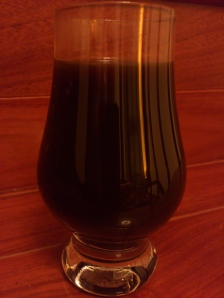 The Black Krampus
The Black Krampus
2 oz Islay Scotch
1/2 oz Fernet Branca
1/2 oz blackstrap molasses
Warm a glass with hot water for a few minutes before discarding. Dissolve molasses in 3 oz of near-boiling water. Add the booze and stir. Serve hot.
Optional additions: grated nutmeg or a twist of lemon might make nice garnishes, but I didn’t have any on hand to try. Fees Brothers Black Walnut Bitters are good, and help with the ‘black’ theme, but you need a good 4 or 5 dashes to stand up to the other strong ingredients. Edit: and I just discovered that a few dashes of orange bitters (Angostura) – instead or as well as the Black Walnut – cuts through the nastiness very well.
Verdict: It looks like motor oil in colour and consistency. It tastes like Chinese medicine. That said, the three powerhouse ingredients do balance each other out quite well, and if you like strong bitter flavours, you might like it. Also, I swear it’s doing wonders for my sore throat.
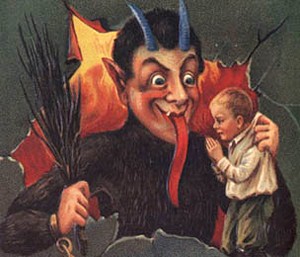 Certainly a toddy for Krampus, or perhaps one to leave out for Santa (if you don’t want him to come back next year).
Certainly a toddy for Krampus, or perhaps one to leave out for Santa (if you don’t want him to come back next year).

Merry Christmas!!! (and don’t be too good)
Hot Toddy – A Template
December 8, 2012
The last week or so, I’ve been messing around with a template recipe for some hot toddy variations. It’s a little rough, but I got a few nice results.
Reading a few blogs, I’ve noticed that I’m not the only one drinking hot drinks these days, as the weather turns cold in the Northern Hemisphere. It’s not freezing in Taiwan yet, but it has been cold, grey, wet and miserable. Perfect Hot Toddy weather.
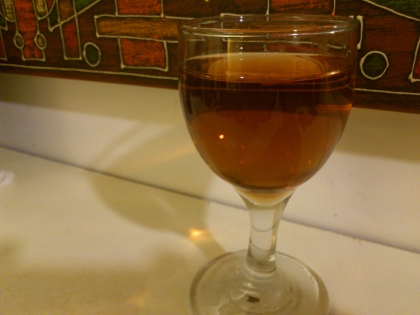 Most modern recipes for Hot Toddies are whiskey (or other spirit), honey and lemon juice, with some cinnamon and cloves, but this not what the original hot toddy was. David Wondrich explains (and the old recipe books back him up) that the Toddy (hot or cold) was a descendent of the punch, with the fruit taken out. The recipe goes something like this:
Most modern recipes for Hot Toddies are whiskey (or other spirit), honey and lemon juice, with some cinnamon and cloves, but this not what the original hot toddy was. David Wondrich explains (and the old recipe books back him up) that the Toddy (hot or cold) was a descendent of the punch, with the fruit taken out. The recipe goes something like this:
Old School Hot Toddy
2 oz spirits
1 tsp sugar
3 oz hot water
That’s it. You should warm the glass with a soak in hot water first. You can grate a little fresh nutmeg on top, too (I haven’t got any, so haven’t tried it). Brown, raw or Demerara sugar is recommended, but white or simple syrup work fine.
Dark spirits tend to work best, with Scotch, Rum, Brandy and Bourbon being favourites. I’ve tried them all before and last week (the first day it got cold) had one with Woodford Reserve that was delicious.
After that experience I wondered about varying the recipe with liqueurs for sweetener. This is something which the writer’s don’t really suggest, but I thought worth a try. Then I got fancy (my first attempt lacked something) and tried adding some extra strong flavour in small quantities. That gave me this template:
Fancy Toddy Template
2 oz spirits
1/2 oz sweet liqueur
1 tsp strong modifying agent
It could probably do with improvement, and might not be to the taste of purists, but it’s certainly fun playing around with on cold winter nights.
The drink that led me to experiment with this template was made with (sadly the last of) my bottle of Bowmore 12-Year Islay Scotch. Toddies usually call for smooth single malts, but I’d decided they’d be much nicer with a bit of a kick, and I think a smokey Islay really works. I think I had a drink called ‘Under the Tartan Sun’ (from Boozehound) in mind when I thought of Tuaca as a sweetener. Tuaca is an Italian vanilla liqueur, so you could also use Licor 43, or maybe even Galliano. I thought it still wanted a little something and I felt that was Fernet Branca, the beautiful bitter minty ameri.
Scotch Toddy
2 oz Islay Scotch
1/2 oz Tuaca
1 tsp Fernet Branca
3 oz hot water
It was great. 5/5
 Next day (or possibly the same night) I went for brandy, and did it B & B style.
Next day (or possibly the same night) I went for brandy, and did it B & B style.
Brandy Toddy
2 oz Cognac
1/2 oz Benedictine
1/2 tsp absinthe
Also very good. 4/5
Next I tried gin, and think I have to agree that aged spirits work better in Hot Toddies. The first attempt (with Botanist, Yellow Chartreuse and Maraschino – I don’t know why I thought it might work) was just awful. The second matched some floral flavours, was alright and could be worked on.
Hendrick’s Toddy
2 oz Hendrick’s Gin
1/2 oz St Germain Elderflower Liqueur
2 drops rose water
It was alright. The flavours matched nicely, but it was rather thin. 3/5
Next was rum. I started with the high-proof Bundaberg OP and realised that you can’t use high-proof spirits (or too much spirits) in Hot Toddies. The evaporating fumes make it impossible to drink for a couple of minutes. I had to use my only other aged rum at the moment, Havana Club Especial. It was still a great drink, but I think a more full-bodied sweeter rum would have been better. Having never made Tiki drinks I was also not sure about the (Fees) Falernum. Really, I just threw it in for the hell of it. I was, perhaps, forcing things to fit the template. But it ended up really improving the drink, so why not?
Rum Toddy
2 oz dark rum
1/2 oz Chambord Raspberry Liqueur
1-2 tsp Falernum
Great. It only misses out on 5 stars because I think a more suited rum would have been better 4.5/5
Next I tried Calvados, which is true apple brandy (that is not a liqueur called brandy, but a distillate made from apples). I think I was reaching for things to match it with, but the Chartreuse more or less worked, and I think Angostura suits Calvados. I really wanted to try it with Peach Liqueur, but didn’t have any. The result was fairly nice, but nothing special.
Calvados Toddy
2 oz apple brandy
1/2 oz Yellow Chartreuse
3 dashes Angostura Bitters
O.K. 3/5
Finally I tried a toddy with Genever – the Dutch ancestor of gin, and a bit of a favourite of mine, although I never really know what to mix it with. The ingredients I ended up with – Cynar artichoke liqueur and rhubarb bitters – were a weird match, and though I really liked it, I’m not sure that many other people would.
Genever Toddy
2 oz Genever
1/2 oz Cynar
1 dash rhubarb bitters (Fees)
I liked it, but doubt it would have broad appeal, so 3.5/5.
And that’s it. I can’t really say that any of these are better than plain Woodford Reserve Bourbon with sugar, but it’s good to have a variety. Do you have any favourite toddy recipes?
Linkage
December 1, 2012
Long overdue, I’m adding some links to other blogs on my front page.
When I started this blog, I was not a blog reader. I still don’t read all that many, but a pleasant surprise of writing my own blog was discovering the friendly and supportive cocktail blogging community.
There are big old famous blogs and there are great new ones. This small selection is by no means comprehensive, but just a few of my favourites.
But before I share, I have a sincere question: What are your favourite cocktail, Taiwan or otherwise relevant blogs? I’m keen to discover more good blog reads. Drop a comment and let me know.
.
.
Drinks Blogs
.
Stuart grows food, photographs it, cooks delicious meals, blogs about and mixes up a cocktail to celebrate. A wonderfully holistic blog.
.
.
Alicia introduced me to the practice of infusing spirits to make your own liqueurs; something that is not nearly as difficult as it sounds. I’ve made about five so far, and loved every one.
.
.
A great cocktail blog from an enthusiastic hobbyist.
.
.
Certainly the nicest looking blog I read and the cocktail writing is great too.
.
.
Rhett is a working bartender with a great blog. I particularly like his ‘science‘ posts about such topics as the science of taste.
.
.
My old friend Seamus is from New Zealand, like me, but I met him in Taiwan over a decade ago. I’m still here, and he’s now in China where he writes for their national magazine ‘Drinks’. His blog has been dormant for years, but is just now stirring back into life, so go and check it out.
.
.
Very sporadic nowadays, but my favourite of the ‘old-timer’ cocktail blogs.
.
.
An event rather than a blog. Once a month, cocktail bloggers join together to post about their mixological experiences or discoveries based on a pre-arranged theme. The results end up on a different host blog each month, but the main blog here will point you there.
.
.
Taiwan Sites
.
A Hungry Girl’s Guide to Taipei is the premiere English-language guide to the wonderful world that is eating out in Taiwan. I’m getting hungry just thinking about it.
.
.
The newcomer to Taipei food blogs, Jaysun approaches his topic with passion. There’s certainly enough eating to go around.
.
.
A wine-lover’s guide to tea: Great concept and the perfect country for it.
.
.
Graci is another New Zealander living in Taiwan, and making waves with her ‘moody’ online cooking show.
.
.
The big daddy of Taiwan English-language forums.
.
.
Smaller (and possibly friendlier) Taiwan forums and business directory.
.
.
Outstanding site for everything that’s going on in the Taiwan music scene.
.
.
Gin Tasting – Premium Gins
November 17, 2012
Saturday afternoon, my good friend is visiting the country, we have a scheduled power cut for five hours, and there’s torrential monsoon rain outside. What to do?
Cue my second round of gin tasting.
The first time I did something like this was several months ago and was much more basic. That time, I tried some very different products – Tanqueray, Plymouth, Old Tom and Genever.
This time around I set up three premium gins with three more regular brands (except that most bars would probably call the regular ones ‘premium’ and the others ‘super-premium’ or something).
My friend, my wife and I tried them all straight (after a little nosing), with a little water and in a gin and tonic (2 parts Schweppes tonic to 1 part gin with lemon wedge). Several weeks later, with a different friend, we did it again, but this time with a Martini (4:1 with Martini & Rossi and a dash of orange bitters + lemon twist) instead of gin and tonic. And we had a new gin, too. They weren’t blind tests. I had some knowledge of the brands (although I hadn’t read anything recently) but the other two were unencumbered by pre-formed expectations.
I have to say that none of us are expert tasters, and speaking for myself at least, I’m pretty awful at identifying smells and flavours. I can basically pick out sweet, sour, bitter, yucky and yummy.
I remember a long time ago Googling phrases like “What is the best brand of gin?” I now know that it’s not a good question. There are loads of quality brands and they all depend on your tastes, your mood, and what you’re mixing with. If you’re a gin fan, you wouldn’t rely on just one brand any more than a wine-lover would only drink one kind of wine.
That said, there were a few winners in our little testing.
Here are the seven we tried, and our thoughts on each. I have included some information from the makers or other sources about their botanicals used. That doesn’t mean we actually tasted all of them! Also, note the alcohol by volume. This differs in different markets – some countries or states tax spirits with higher ABV much higher, so these strengths are not usually sold. I prefer a good 47% or so strength for gin, especially for mixing, but it’s possible that the bottling we tasted is different from that available to you locally. All of these are available in Taipei, and I’ve noted where.
Plymouth Gin
Plymouth is the only gin in this taste-test that isn’t, strictly speaking, a ‘London Dry’ style of gin. It’s technically the surviving example of it’s very own category ‘Plymouth Gins’. That said, the basic taste profile is not that different. In fact, it’s closer to a ‘clean’ London Dry style than many gins with a more ambitious use of botanicals, so can make a good ‘neutral’ gin in cocktails.
ABV: 41.2%
Botanicals: juniper, angelica root, cardamom pods, coriander seeds, lemon peel, orange peel, orris root
Plymouth Gin is made in a 155-year-old copper pot still and is said to be distinguished by its ‘buttery’ base spirit and the naturally peaty granite-filtered water from the local Dartmoor Reservoir.
Tasting: We could taste light juniper, a little citrus and ‘lemon zestiness’. It tasted weaker and emptier others such as Tanqueray. Water didn’t improve it. It was much nicer in a gin and tonic, where we thought it was good. In the Martini the vermouth overpowered it.
Conclusions: Plymouth is nice; it just seemed weak and boring up against the other gins in our test. That said, it’s a popular mixing gin these days and I’ve come to appreciate it as such. It seems to go very well in Negronis and other cocktails which need a bit of orange citrus flavour. Orange bitters are a good match with Plymouth. Also when making earlier cocktails (ie pre-1890), Plymouth may be a better fit than London dries. It can go well in a drink where you want the gin to be a bit more subtle.
Availability in Taiwan: 9 City
Broker’s Gin
Although Broker’s is fairly new (1998) it is made to a 200-year-old recipe in an old distillery that is the same age. The botanicals used are all traditional gin botanicals, so it is a very traditional London Dry style gin. The first thing you notice about Broker’s is the bowler cap on the stem. Some hate it as a gimmick, but I think it’s cute. Just be sure to take it off if you’re using it often – it could easily make you drop the bottle.
ABV: 40%
Botanicals: juniper, coriander, orris, nutmeg, cassia bark, cinnamon, liquorice, orange peel, lemon peel, angelica root
Broker’s is made in a copper pot still with water from an underground spring at the distillery.
Tasting: We tasted strong juniper and the classic gin profile. We thought it was very similar to Tanqueray, but with perhaps a bit more citrus (and looking up the ingredients later seems to bear this out). Drinking neat, my wife thought it was a little lighter than Tanqueray, and my friend described it as a ‘gin hit in the mouth’. We thought it improved with the addition of water, but failed somewhat in a gin and tonic, lacking character. Tasting it on the second occasion, I thought it much better than the first time, and it tasted good in a Martini.
Conclusions: Broker’s suffered in our test as we thought Tanqueray was very similar, but better. That’s not surprising as both are very classic London Dry styles. That said, it’s still a very good gin, and you might like it if you feel that Tanqueray is a little too brash.
Availability in Taiwan: Carrefour, Breeze
Tanqueray is probably the most well-known of the gins in our taste-test, and perhaps also best epitomises the characteristics of a traditional London Dry style of gin. Its botanicals are part of a secret recipe, but are thought to be few – as little as four – with only three given by the distillers themselves. Started in London in the 1830s, Tanqueray is now produced in Scotland (much of the distillery was destroyed in the blitz).
ABV: 47.3%
Botanicals: juniper, coriander, angelica, and (widely assumed) liquorice
Tanqueray is now made in copper pot stills, including the 200-year-old ‘Old Tom’.
Tasting: We tasted strong juniper, a little spice and a hint of lemon. From the ‘nosing’ onwards, we all thought that Tanqueray was THE classic expression of gin. For me it just tastes ‘ginnier’ than all other gins. It was also described as ‘velvety’, full-bodied, dry tasting and tonic-like. The addition of water improved it. In a gin and tonic it was one of the very best, and also what we all thought of as the quintessential G’n’T. It was great as a Martini as well.
Conclusions: Tanqueray is my ‘go-to’ gin. I use it as the ‘default’ whenever trying a new gin cocktail. The 47% we get here stands up well to other ingredients, and it’s just ‘the classic’ London Dry profile. I know some think it’s too heavy on the juniper, but for me, more juniper just means more gin-like. Tanqueray was one of our top picks.
Availability in Taiwan: Carrefour and many bottle stores
Darnley’s is a very new gin dating back only to 2010. It is made by the Scotch-producing Wemyss family near Edinburgh, but is a fairly traditional, though light, London Dry style. The name is based on the view Mary Queen of Scots had of her future husband Lord Darnley, who was to father James VI of Scotland, who became James I of England, uniting Scotland and England (presumably in the same way that Darnley’s unites English and Scottish gin. I think it’s a stupid name.)
ABV: 40%
Botanicals: juniper, lemon peel, coriander seed, angelica root, elderflower and orris root
Tasting: We tasted weak juniper and a little citrus. Overall, we simply found it weaker and duller than most of the others. We thought the addition of water only brought out the flavours a little. We thought the gin and tonic rather boring and the Martini weak and watery.
Conclusion: I feel sorry for Darnley’s View; it seems like the real loser in our taste testing. But it’s certainly not a bad gin. I find the bottle alluring and am never disappointed when I take a sip. Maybe we missed it’s subtleties, as I’ve since found it to perform very well in Negronis, although I still doubt it’s ability to stand up well in most classic cocktails.
Availability in Taiwan: Megacity Mall City Super
Started ten year’s ago by an antiques entrepreneur, Martin Miller’s gin has a few interesting qualities. Firstly, the earthier botanicals are distilled separately from the citrus ones before being blended. A small amount of distilled cucumber is also added as a drying agent. After distillation, as portrayed on the (very nice looking) bottle, the gin is transported to Iceland to be blended with what they call the ‘purest water in the world’, which is apparently super oxygenated with a high surface tension which gives the gin a softer gentler taste.
ABV: 40%
Botanicals: juniper, coriander, angelica, lemon peel, orange peel, orris root, powdered licorice, nutmeg, cinnamon, and cassia bark
Martin Miller is distilled in a 100-year-old pot still called ‘Angela’.
Tasting: We tasted citrus and cucumber. We all had great first impressions of this gin. It could have been the excellent marketing and image of the bottle at work, or it could have ben truly living up to its image, but we all thought Martin Miller tasted exceptionally fresh with a smooth arctic coolness and not so much bite as more juniper-forward gins. We eventually identified with instant certainty the cucumber taste as one of the main reasons for this. Hendricks is known for cucumber, but I think you can taste it much more clearly in the Martin Miller, where it works very well. The addition of water improved the flavours and it was great in a gin and tonic (which I also later tried with a cucumber garnish which was also very nice). The vermouth seemed to accentuate these tastes making for an exceptional, albeit rather non-standard, expression of the Martini.
Conclusions: Undoubtedly a winner for all three us in this taste-testing, Martin Miller is an exceptional fresh and refreshing cool summer gin. That said, you’d have proceed with caution when mixing classic drinks, as its profile is so non-standard. But G’n’Ts and Martinis alone easily justify buying this gin. This could also be a good gin to lure vodka drinkers onto the true path.
Availability in Taiwan: 9 City, Breeze
Hendrick’s Gin, also little over ten years old, is made in Scotland. Its smooth marketing brands it as an unusual gin, and plays up its additives of rose and cucumber – spearheading the use of cucumber in place of lemon/lime in a G’n’T. Its distinctive opaque bottle adds to the image of a distinctive gin.
ABV: 41.5%
Botanicals: quite secret, but seem to include juniper, coriander, citrus, angelica, orris
Hendrick’s is distilled partly in a Bennet copper pot still, and partly in a rare Carter-head still where the more floral botanicals are added. These two distillates are then blended to make the final gin after the addition of cucumber and Bulgarian rose distillates.
Tasting: The scent of Hendricks was floral and perfumy, and the nice floral qualities came through when tasting it neat and with water. Juniper was in the background. We couldn’t taste the cucumber, but that might have been what made the Hendricks taste smoother than most of the other gins. Hendricks made one of the best gin and tonics in our test, but was middle of the bunch for Martinis.
Conclusions: We were very impressed with Hendrick’s in our first round of tasting (with gin and tonics) but a little less so in the second round (with Martinis). Hendrick’s seems to polarise a little, with many loving it and many finding it over-hyped. I tend to towards the former camp, but wouldn’t go the way of the Wall Street Journal and call it the best gin in the world. This is a good gin for cocktails where you are mixing with other floral ingredients.
Availability in Taiwan: 9 City and quite a few other bottle stores
Islay Scotch producers of the Bruichladdich distillery widen their portfolio with this aptly named gin containing 9 standard botanicals and a further 22 special botanicals all sourced from Islay itself. That’s 2-4 times as many botanicals as in most gins, which could make it either a gin of unmatched complexity or a complete mess of too many flavours.
ABV: 46%
Botanicals: juniper berries, angelica root, cassia bark, cinnamon bark, coriander seed, lemon peel, orange peel, liquorice root, orris root, apple mint birch leaves, bog myrtle leaves, chamomile, creeping thistle flowers, elderflower, gorse flowers, heather flowers, hawthorn flowers, juniper (prostrate) berries, Lady’s Bedstraw flowers, lemon balm, meadowsweet, peppermint leaves, mugwort leaves, red clover flowers, sweet cicely leaves, tansy, thyme leaves, water mint leaves, white clover, wood sage leaves
The Botanist is slow-distilled in a 60-year-old Lomond pot still called Old Betty. The standard botanicals are macerated first and the local botanicals are added via an infusion basket in the still. Islay spring water is used in the distillation and bottling.
Tasting: We tasted juniper and strong herbal flavours. We thought it dry and fairly bitter, but certainly interesting. I didn’t have this for our first round of tasting, so we didn’t try it in a side-by-side gin and tonic test. I made one later though and thought it fine. However, it really shone in the Martini. It was very herbal with a touch of cinnamon.
Conclusions: The Botanist was one of our favourites in the Martini – complex, distinctive and fascinating (though again quite non-standard). I wouldn’t use it in recipes calling for a normal London Dry, at least not expecting a normal result. This is another gin for appreciating on its own, in Martinis or with simple mixers. It’s not a refresher, but a gin for those who like a nice complex drink.
Availability in Taiwan: 9 City
Summary
The gin-tastings were a fun experience and a great way to get to know some gins and see the differences between them. Honestly, there were no winners, but going up against other heavy hitters left some otherwise excellent gins tasting boring and nondescript.
Plenty of gins that are available in Taipei were left out (I can only buy so many at once): Beefeater (a great traditional gin), Bombay Sapphire, Tanqueray No. 10, Greenall’s, Gordon’s (which I don’t care for), The London No.1 and more. I want to try them all sometime.
I expected it, but it’s very clear that there is no ‘best gin in the world’. It all depends on not only your own preferences, but what you’re mixing it with and what sort of mood you’re in.
Awards
Best gin for gin and tonic: Tanqueray, Martin Miller and (runner-up) Hendrick’s
Best gin for Martini: Tanqueray, Martin Miller and The Botanist
Best traditional gin: Tanqueray
Best atypical gin: Martin Miller (runners-up: Hendrick’s and The Botanist).
What should I be trying next? What’s your favourite gin?
Table of (Known and Assumed) Botanicals
| Tanqueray | Darnley’s | Hendrick’s | Plymouth | Broker’s | M Miller | Botanist | |
| juniper | √ | √ | √ | √ | √ | √ | √ |
| coriander | √ | √ | √ | √ | √ | √ | √ |
| angelica | √ | √ | √ | √ | √ | √ | √ |
| orris | √ | √ | √ | √ | √ | √ | |
| lemon | √ | √ | √ | √ | √ | √ | |
| orange | √ | √ | √ | √ | √ | ||
| liquorice | √ | √ | √ | ||||
| cassia | √ | √ | |||||
| cinnamon | √ | √ | |||||
| nutmeg | √ | ||||||
| elderflower | √ | √ | |||||
| cardamom | √ | √ | |||||
| others | √ |
Further Reading
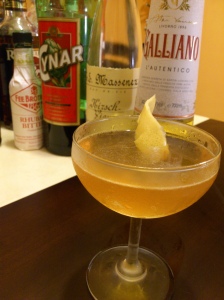

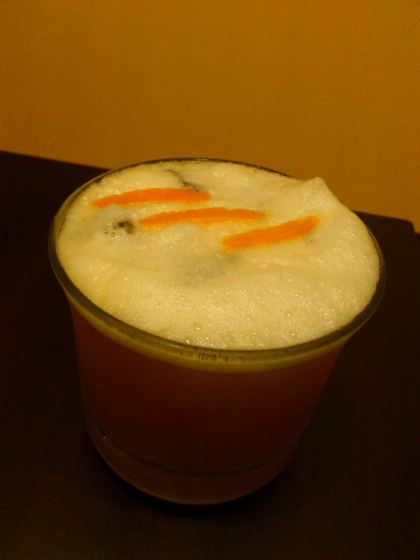
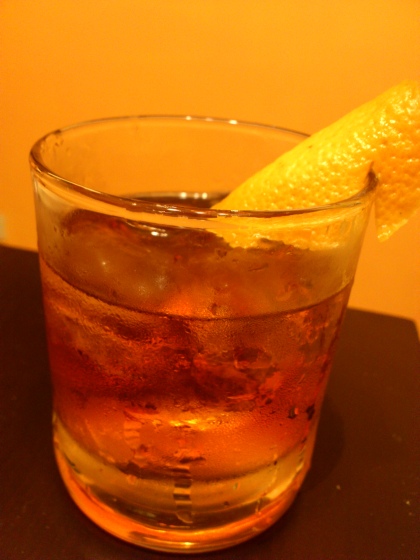

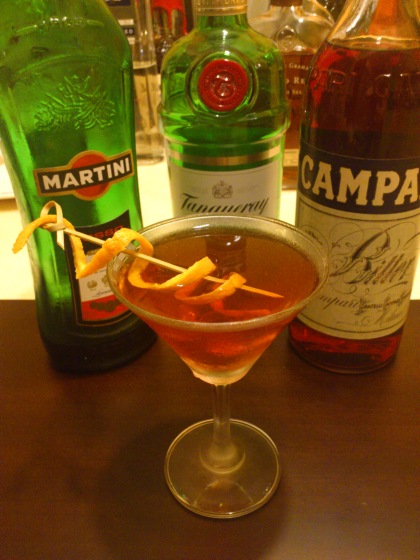

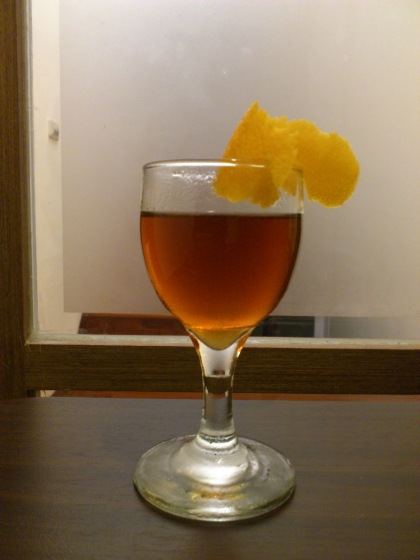

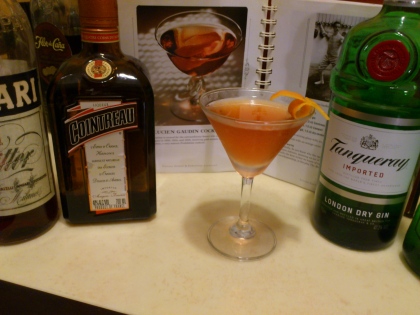

 Well, not booze – cocktail and bartending supplies.
Well, not booze – cocktail and bartending supplies.
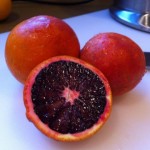 Putney Farm
Putney Farm Boozed and Infused
Boozed and Infused
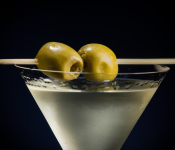 Cold Glass
Cold Glass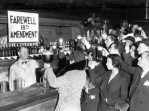
 Bunnyhugs
Bunnyhugs Jeffrey Morgenthaler
Jeffrey Morgenthaler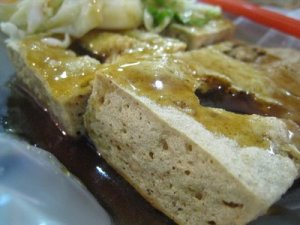 Hungry Girl
Hungry Girl Jaysun Eats Taipei
Jaysun Eats Taipei Tearroir
Tearroir Graci in the Kitchen
Graci in the Kitchen Forumosa
Forumosa Taiwanease
Taiwanease Gig Guide Taiwan
Gig Guide Taiwan




